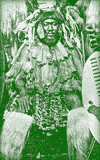|
Strict stipulations apply in terms of who succeeds to the throne and while many of these are closely guarded secrets it is generally known that the king must be the only child of his mother and unmarried. Thus the Swazi kings are always young men when they come to the throne.
The present monarch, King Mswati III ascended the throne in 1986 at the age of 18, succeeding his father King Sobuza II, a widely respected and loved man who was also the world's longest reigning monarch, ruling from 1921 until 1982.
The monarchy has endured throughout Swaziland's history, often in adverse situations. During the second half of the nineteenth century foreign settlers acquired valuable land for agriculture and commercial use. King Sobuza II was instrumental in reacquiring much of this land for the people and today this is known as Swazi Nation Land.
  
Swaziland became a protectorate in 1903 when British colonial rule was established and retained this status until she became a self-governing state 1967 when Sobhuza II was officially recognised internationally as a king and the country acquired her own flag. The following year independence was achieved but the monarchy has remained firmly entrenched to promote stability and peace, as well as safeguarding the cultural heritage.

The People and Traditions
Cultural snippets: The tale of the tail | The traditional Swazi homestead | Rituals
|
